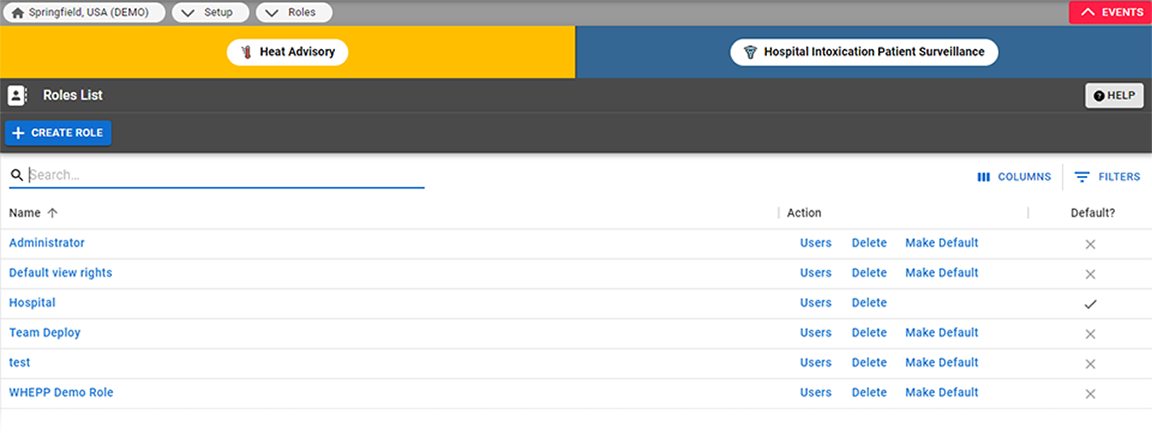The roles you create and assign to your users govern the views and features that are available to them. Each role grants a predefined set of rights that dictate the features in EMResource the user can access and use, including:
Views and resources (and sub-resources) the user can access
Status types the user can view and/or update
Access to reports and forms
Ability to manage events and send notifications
There is no limit to the numbers of roles you can create or the combination of rights you can set up for each role.
Roles List
With appropriate permissions, you can view your region's roles in the Roles List, which also indicates the region's default role.
The Roles List provides access to maintenance features, such as creating and editing roles, specifying a default role for your region, managing a role's users, and more.
Note: At least one role must be assigned to each user.
Administrator Roles
EMResource roles and rights are very flexible. Your region can create numerous roles and assign rights to each. These rights determine whether the users assigned to that role can perform some level of administrative tasks. For example, your region probably has a hospital administrator role, which allows these users to update their resource's statuses, edit their resource's details, create and maintain events, and run status summary reports. In contrast, a hospital user might be allowed to update their resource's statuses, and may even be required to do so. Users with this role might also be able to update event statuses, but then have no other access to event administration.
Your region may be set up to allow delegated user management. If this feature is enabled, the regional administrator can assign resource administrators. While this is a "role" within your region, it is not enabled or set up in the same way as other EMResource roles. For details on this feature, refer to About Resource Administrators.
Region Default Role
It is likely your region specified a default role. In many cases, your default role grants basic resource viewing rights. This role is automatically assigned to each new user, ensuring they have at least one role and some rights within the application. A region can have only one default role. In the Roles List, the default role is indicated by Yes in the Default? column. Keep in mind that this default role is also automatically assigned to any user from another region who has been granted to right to log in to your region.
Examples of Roles and Rights
The following table lists a few examples of roles and the rights that generally accompany that type of role.
Regional Admin | Hospital Admin | Hospital User | EMS Admin | EMS User | |
|---|---|---|---|---|---|
Setup Region Information | X | ||||
User - Configure Region User Access | X | ||||
Status - User must update overdue status | X | ||||
Setup Resources - Edit Only | X | X | |||
Event - Maintain Events | X | X | X | ||
Report - Status Summary | X | X | X |
